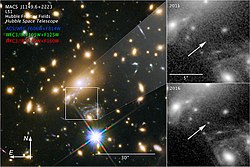 The orbit is highly elliptical, moving outside Mars and inside Mercury. Positions shown for 31 January 2018 before flyby. | |
| Discovery [1] [2] | |
|---|---|
| Discovered by | NEAT |
| Discovery site | Haleakala Obs. |
| Discovery date | 15 January 2002 |
| Designations | |
| (276033) 2002 AJ129 | |
| 2002 AJ129 | |
| Orbital characteristics [3] [4] | |
| Epoch 4 September 2017 (JD 2458000.5) | |
| Uncertainty parameter 0 | |
| Observation arc | 14.23 yr (5,199 days) |
| Aphelion | 2.6254 AU |
| Perihelion | 0.1167 AU |
| 1.3711 AU | |
| Eccentricity | 0.9149 |
| 1.61 yr (586 days) | |
| 288.23° | |
| 0° 36m 50.04s / day | |
| Inclination | 15.449° |
| 138.05° | |
| 211.01° | |
| Earth MOID | 0.0060 AU (2.3 LD) |
| Physical characteristics | |
| 0.5–1.2 km [5] | |
| 18.7 [3] | |
(276033) 2002 AJ129, provisional designation 2002 AJ129, is a Mercury-crossing asteroid. It has the ninth-smallest perihelion of all numbered asteroids, after asteroids such as 2000 BD19 , 2004 UL , and 2008 XM . [6] It makes close approaches to all of the inner planets [3] and asteroid 4 Vesta. [7] The asteroid is estimated to be between 0.5–1.2 kilometers (0.3–0.7 mi) across. [5] In January 2018 there was much media hype about this asteroid being classified as a potentially hazardous asteroid, although there is no known threat of an impact for hundreds if not thousands of years. The media has compared the size of the asteroid to the Burj Khalifa in Dubai. [8]

